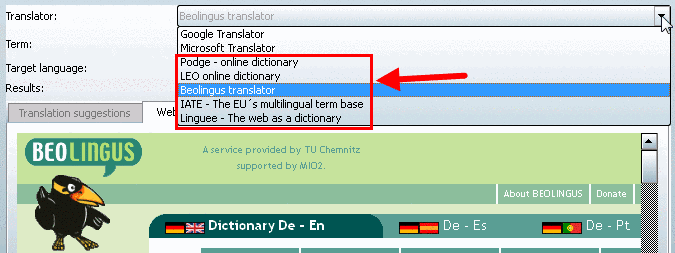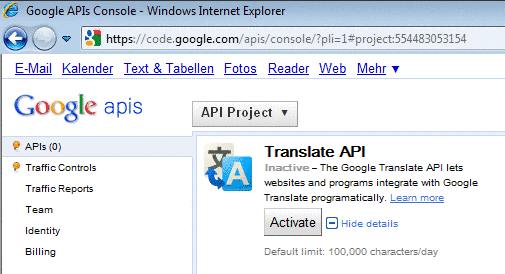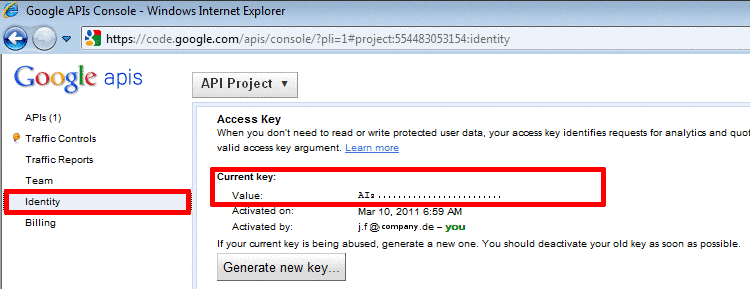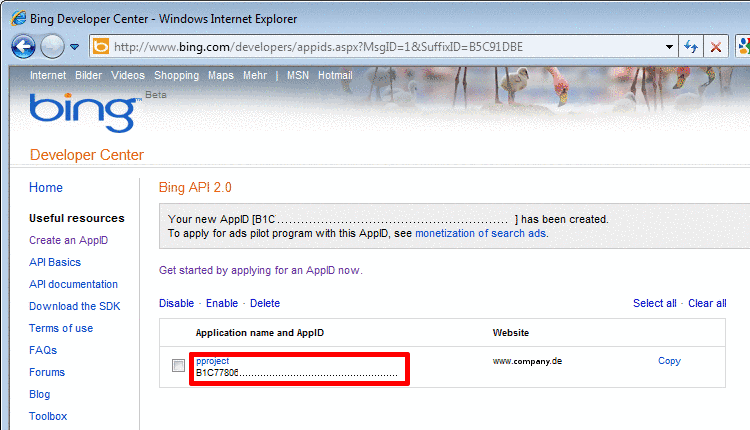Manual
Login
Our 3D CAD supplier models have been moved to 3Dfindit.com, the new visual search engine for 3D CAD, CAE & BIM models.
You can log in there with your existing account of this site.
The content remains free of charge.

Top Links
Manual
Some translation services are already preconfigured and ready to use so that no changes are necessary.[14]
You can add other services in the configuration file any time.
In the following the structure of the configuration file is described in detail.
There are two modes of translation services:
-
Services which provide an API:
At these services the translation proposals are read directly from the API and displayed in the Translate term dialog on the Translation suggestions tabbed page. Compare Fig. „Example: Currently selected translation service: Microsoft Translator“.
![[Note]](/community/externals/manuals/%24%7Bb2b:MANUALPATH/images/note.png)
Note However the user has to deliver a key which is inserted in the configuration file. How to get the key is described under Section 4.7.2.1.13.5.3, “ Google Translator - Create account” and Section 4.7.2.1.13.5.4, “ Microsoft Translator - Create account”.
-
Services which are addressed by an URL:
In order to use these services only an URL is needed. The results display happens in the Translate term dialog on the Web view tabbed page. Compare Fig. „PARTcatalogTranslator: Translation service exemplarily "IATE"“.
The settings for every translation service are made in its own section.
Every section can contain the following keys:
-
SourceLanguages and TargetLanguages:
Comma separated list of supported source and target languages.
The language has to be set using the ISO code.
SourceLanguages=af,aq,ar,be,bg,ca,de,en TargetLanguages=af,aq,ar,be,bg,ca,de,en
-
This key provides the display on the Web view tabbed page.
Each language combination has to be declared separately.
The key has to be adjusted for each translation service individually.
WebUrl_sourceLanguage_targetLanguage=
WebUrl_de_en=http://dict.leo.org/ende?lp=ende&search=$phrase. WebUrl_en_de=http://dict.leo.org/ende?lp=ende&search=$phrase. WebUrl_all_all=http://www.podge.de/.......................... WebUrl_de_all=http://dict.tu-chemnitz.de/....................
Google and Microsoft have two keys in addition:
-
A key to be delivered by user.
Hereto see under Section 4.7.2.1.13.5.3, “ Google Translator - Create account” and Section 4.7.2.1.13.5.4, “ Microsoft Translator - Create account”.
-
ServiceUrl=http://api.microsofttranslator.com/................
This key provides the display on the Translation suggestions tabbed page. The key is already adjusted and should not be changed.
URL addressed services have the following key in addition:
-
Name/description of the service which is displayed in the UI in the Translator list field.
The description text can be localized via configuration file under
../setup/online_translation.def. -
For some translation services an URL encoding has to be defined in order for the parameters to be transferred correctly (e.g. "Service.de/translate?query=Überlauf").
UrlEncoding=ISO 8859-1
The following place holders can be used in the WebUrl and ServiceUrl keys:
In order to be
able to use the Google Translator a key has to be inserted in the
online_translators.cfg
configuration file, in the [GoogleTranslator] section. The other settings
are already made by default and do not have to be changed
In order to get the key a Google Account is needed.
In order to create it proceed as follows:
Call up http://code.google.com/apis/console.
-
-
In the "Identity" category you see your key under "Current key".
-
Copy this key to the
online_translators.cfgconfiguration file, to the [GoogleTranslator] section, into "Key".[GoogleTranslator] Key=............................
In order to be
able to use the Microsoft Translator a key has to be inserted in the
online_translators.cfg
configuration file, in the [MicrosoftTranslator] section. The other
settings are already made by default and do not have to be changed
In order to get the key an "AppID" is needed. The "AppID" corresponds to the needed key.
In order to get it proceed as follows:
-
Click on the link "Get started by applying for an AppID now".
Again insert the requested data in the form and finally click on .
-
Under "Application name and AppID" you see your ID / your key.
-
Copy this key to the
online_translators.cfgconfiguration file, to the [MicrosoftTranslator] section into "Key".[MicrosoftTranslator] Key=....................................
[14] Only for GoogleTranslator and MicrosoftTranslator you have to insert a key named "Key". See under Section 4.7.2.1.13.5.3, “ Google Translator - Create account” and Section 4.7.2.1.13.5.4, “ Microsoft Translator - Create account”.







